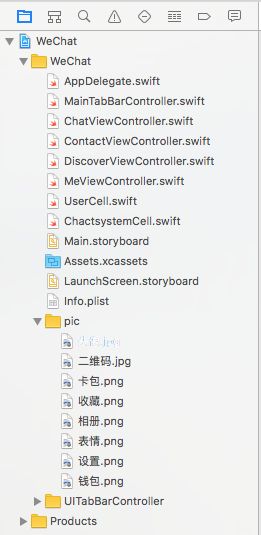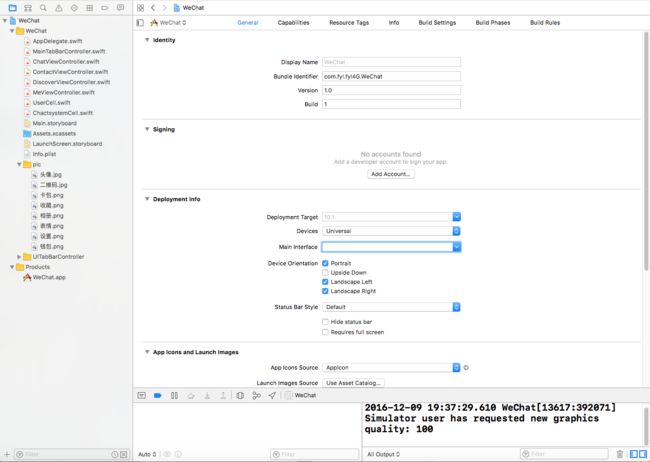- 给每个视图(UIViewController)设置颜色
AppDelegate.swift代码如下:
import UIKit
@UIApplicationMain
class AppDelegate: UIResponder, UIApplicationDelegate {
var window: UIWindow?
func application(_ application: UIApplication, didFinishLaunchingWithOptions launchOptions: [UIApplicationLaunchOptionsKey: Any]?) -> Bool {
self.window = UIWindow(frame:UIScreen.main.bounds)
self.window?.backgroundColor = #colorLiteral(red: 0.4745098054, green: 0.8392156959, blue: 0.9764705896, alpha: 1)
self.window?.makeKeyAndVisible()
//创建标签视图控制器
let tabBarVC = MainTabBarController()
//将标签视图控制器指定为window的根视图控制器
self.window?.rootViewController = tabBarVC
return true
}
MainTabBarController.swift代码如下:
import UIKit
//屏幕的宽
let kScreenWidth = UIScreen.main.bounds.size.width
//屏幕的高
let kScreenHight = UIScreen.main.bounds.size.height
class MainTabBarController: UITabBarController {
override func viewDidLoad() {
super.viewDidLoad()
self.setupViewController()
}
func setupViewController(){
//消息:Chats
let chatVC = ChatViewController()
let chatNC = UINavigationController(rootViewController: chatVC)
chatVC.title = "Chats"
chatVC.tabBarItem.image = UIImage(named: "[email protected]")
//通讯录:Contacts
let contactVC = ContactViewController()
let contactNC = UINavigationController(rootViewController: contactVC)
contactVC.title = "Contacts"
contactVC.tabBarItem.image = UIImage(named: "[email protected]")
//发现:Discover
let discoverVC = DiscoverViewController()
let discoverNC = UINavigationController(rootViewController: discoverVC)
discoverVC.title = "Discover"
discoverVC.tabBarItem.image = UIImage(named: "[email protected]")
//我:Me
let meVC = MeViewController()
let meNC = UINavigationController(rootViewController: meVC)
meVC.title = "Me"
meVC.tabBarItem.image = UIImage(named: "[email protected]")
self.viewControllers = [chatNC,contactNC,discoverNC,meNC]
self.tabBar.tintColor = #colorLiteral(red: 0.4666666687, green: 0.7647058964, blue: 0.2666666806, alpha: 1)
}
override func didReceiveMemoryWarning() {
super.didReceiveMemoryWarning()
// Dispose of any resources that can be recreated.
}
/*
// MARK: - Navigation
// In a storyboard-based application, you will often want to do a little preparation before navigation
override func prepare(for segue: UIStoryboardSegue, sender: Any?) {
// Get the new view controller using segue.destinationViewController.
// Pass the selected object to the new view controller.
}
*/
}
MeViewController.swift代码如下:
import UIKit
class MeViewController: UITableViewController {
let MeCellReuseIdentifer = "userCell"
let chatSystemCell = "chatCell"
let dataSource:[[String]] = [["相册","收藏","钱包","卡包"],["表情"],
["设置"]]
override func loadView() {
let tableView = UITableView(frame: UIScreen.main.bounds, style: .grouped)
self.tableView = tableView
}
override func viewDidLoad() {
super.viewDidLoad()
self.view.backgroundColor = #colorLiteral(red: 0.9568627477, green: 0.6588235497, blue: 0.5450980663, alpha: 1)
self.tableView.register(UserCell.self, forCellReuseIdentifier: MeCellReuseIdentifer)
self.tableView.register(ChactsystemCell.self, forCellReuseIdentifier: chatSystemCell)
// Uncomment the following line to preserve selection between presentations
// self.clearsSelectionOnViewWillAppear = false
// Uncomment the following line to display an Edit button in the navigation bar for this view controller.
// self.navigationItem.rightBarButtonItem = self.editButtonItem()
}
override func didReceiveMemoryWarning() {
super.didReceiveMemoryWarning()
// Dispose of any resources that can be recreated.
}
// MARK: - Table view data source
override func numberOfSections(in tableView: UITableView) -> Int {
// #warning Incomplete implementation, return the number of sections
return 4
}
override func tableView(_ tableView: UITableView, numberOfRowsInSection section: Int) -> Int {
// #warning Incomplete implementation, return the number of rows
return section == 1 ? 4 : 1
}
override func tableView(_ tableView: UITableView, heightForRowAt indexPath: IndexPath) -> CGFloat {
return indexPath.section == 0 ? 100 : 50
}
override func tableView(_ tableView: UITableView, cellForRowAt indexPath: IndexPath) -> UITableViewCell {
//返回UserCell
if indexPath.section == 0 {
let cell = tableView.dequeueReusableCell(withIdentifier: MeCellReuseIdentifer) as! UserCell
cell.userPic.image = #imageLiteral(resourceName: "头像.jpg")
cell.userNameLable.text = "风的低语"
cell.userIDLable.text = "微信号:fyl13314749700"
cell.userQRView.image = #imageLiteral(resourceName: "二维码.jpg")
return cell
}else{//返回ChactsystemCell
let cell = tableView.dequeueReusableCell(withIdentifier: chatSystemCell) as! ChactsystemCell
let group = dataSource[indexPath.section - 1]
let str = group[indexPath.row]
cell.iconView.image = UIImage(named: str)
cell.infoLable.text = str
return cell
}
}
/*
// Override to support conditional editing of the table view.
override func tableView(_ tableView: UITableView, canEditRowAt indexPath: IndexPath) -> Bool {
// Return false if you do not want the specified item to be editable.
return true
}
*/
/*
// Override to support editing the table view.
override func tableView(_ tableView: UITableView, commit editingStyle: UITableViewCellEditingStyle, forRowAt indexPath: IndexPath) {
if editingStyle == .delete {
// Delete the row from the data source
tableView.deleteRows(at: [indexPath], with: .fade)
} else if editingStyle == .insert {
// Create a new instance of the appropriate class, insert it into the array, and add a new row to the table view
}
}
*/
/*
// Override to support rearranging the table view.
override func tableView(_ tableView: UITableView, moveRowAt fromIndexPath: IndexPath, to: IndexPath) {
}
*/
/*
// Override to support conditional rearranging of the table view.
override func tableView(_ tableView: UITableView, canMoveRowAt indexPath: IndexPath) -> Bool {
// Return false if you do not want the item to be re-orderable.
return true
}
*/
/*
// MARK: - Navigation
// In a storyboard-based application, you will often want to do a little preparation before navigation
override func prepare(for segue: UIStoryboardSegue, sender: Any?) {
// Get the new view controller using segue.destinationViewController.
// Pass the selected object to the new view controller.
}
*/
}
UserCell.swift代码如下:
import UIKit
class UserCell: UITableViewCell {
//用户头像
var userPic:UIImageView!
//用户名
var userNameLable:UILabel!
//用户帐号
var userIDLable:UILabel!
//用户二维码
var userQRView:UIImageView!
override init(style: UITableViewCellStyle, reuseIdentifier: String?) {
super.init(style: style, reuseIdentifier: reuseIdentifier)
self.setupViews()
}
func setupViews(){
//用户头像
userPic = UIImageView(frame: CGRect(x: 15, y: 10, width: 80, height: 80))
self.contentView.addSubview(userPic)
//用户名
userNameLable = UILabel(frame: CGRect(x: 110, y: 15, width: 100, height: 30))
self.contentView.addSubview(userNameLable)
//用户帐号
userIDLable = UILabel(frame: CGRect(x: 110, y: 55, width: kScreenWidth*0.6, height: 30))
self.contentView.addSubview(userIDLable)
//用户二维码
userQRView = UIImageView(frame: CGRect(x: kScreenWidth*0.8, y: 30, width: 47, height: 47))
self.contentView.addSubview(userQRView)
}
required init?(coder aDecoder: NSCoder) {
fatalError("init(coder:) has not been implemented")
}
override func awakeFromNib() {
super.awakeFromNib()
// Initialization code
}
override func setSelected(_ selected: Bool, animated: Bool) {
super.setSelected(selected, animated: animated)
// Configure the view for the selected state
}
}
ChactsystemCell.swift代码如下:
import UIKit
class ChactsystemCell: UITableViewCell {
//图片
var iconView:UIImageView!
//说明
var infoLable:UILabel!
override init(style: UITableViewCellStyle, reuseIdentifier: String?) {
super.init(style: style, reuseIdentifier: reuseIdentifier)
self.setupViews()
}
//cell高50
func setupViews(){
//图片
iconView = UIImageView(frame: CGRect(x: 15, y: 10, width: 30, height: 30))
self.contentView.addSubview(iconView)
//说明
infoLable = UILabel(frame: CGRect(x: 55, y: 10, width: 100, height: 30))
self.contentView.addSubview(infoLable)
}
required init?(coder aDecoder: NSCoder) {
fatalError("init(coder:) has not been implemented")
}
override func awakeFromNib() {
super.awakeFromNib()
// Initialization code
}
override func setSelected(_ selected: Bool, animated: Bool) {
super.setSelected(selected, animated: animated)
// Configure the view for the selected state
}
}

